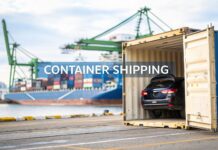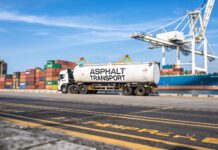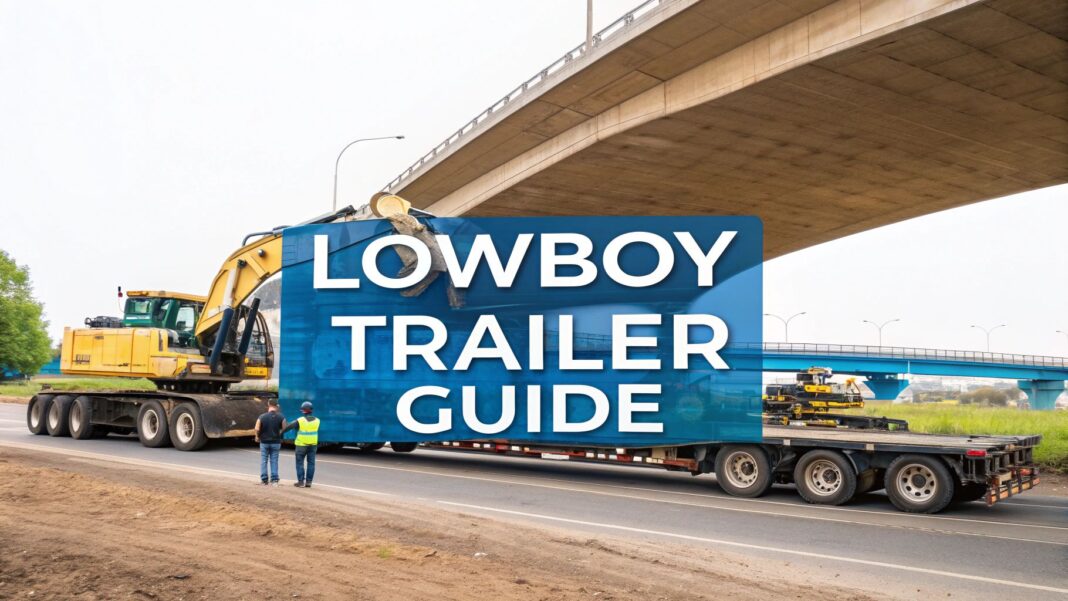
When you need to transport something truly massive—like an excavator, bulldozer, or critical industrial machinery—a standard flatbed trailer simply won't suffice. This is where the lowboy trailer becomes essential. It’s a specialized semi-trailer with a deck that sits extremely close to the ground, engineered for one primary purpose: hauling oversized and overweight cargo that would violate height restrictions on any other type of trailer.
The key is its unique two-level drop deck design. This creates a "well" in the middle that allows towering equipment to ride low, ensuring it safely clears bridges, overpasses, and power lines. For anyone involved in heavy haul transport, understanding this trailer is non-negotiable.
What Makes a Lowboy Trailer Essential for Heavy Hauls
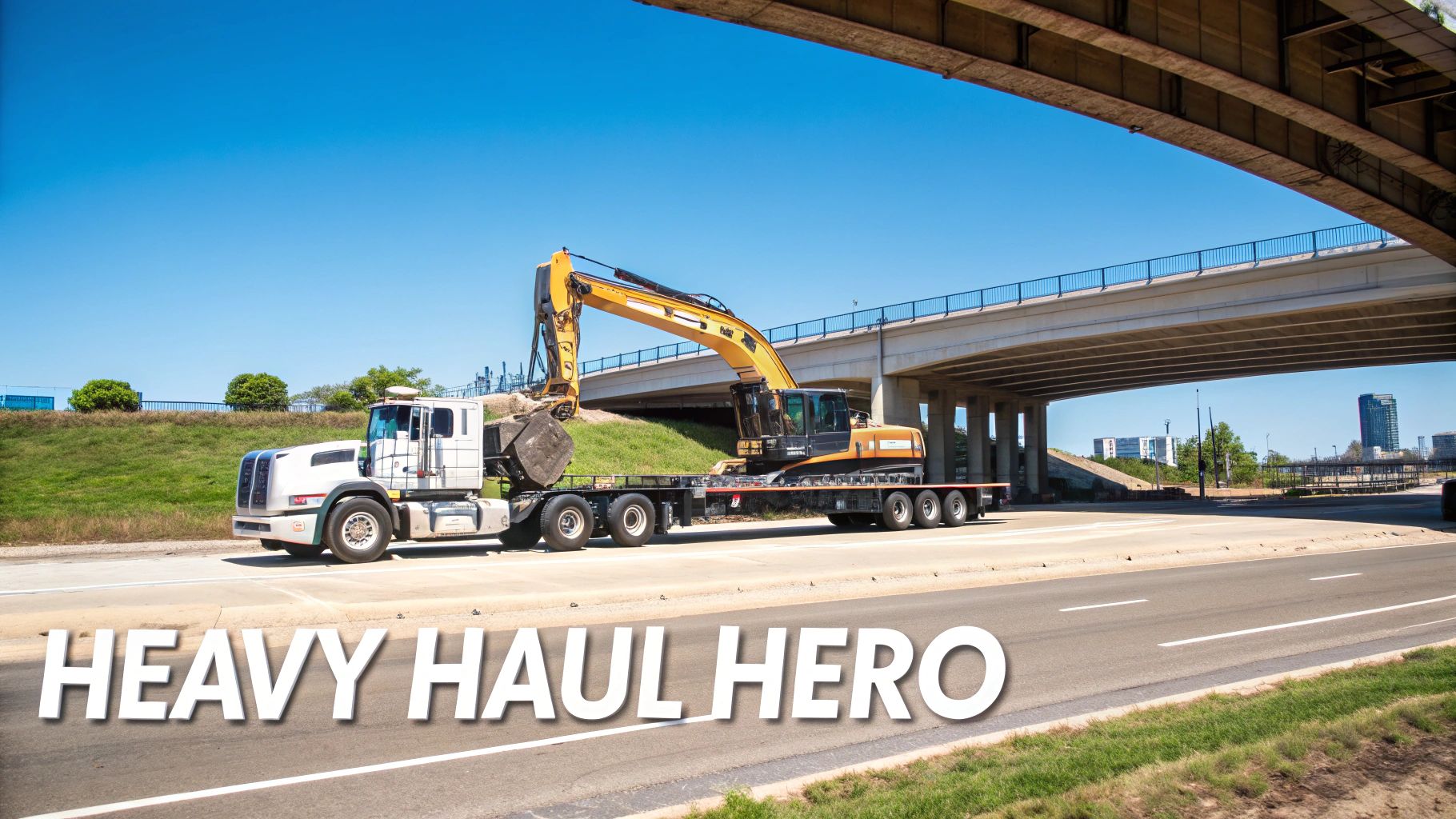
Imagine you need to move a 40-ton excavator from one job site to another, 50 miles away. Placed on a standard flatbed, the machine's height would exceed the legal limit of 13.5 feet, making the transport illegal and dangerously prone to striking overpasses. This is the exact transport problem the lowboy trailer was engineered to solve.
The lowboy is the undisputed workhorse of the heavy transport industry. Its most critical feature is the ultra-low deck, which often sits just 18 to 24 inches off the ground. This design provides the crucial vertical clearance needed to move tall machinery, making it indispensable for sectors like construction, agriculture, and energy.
The Backbone of Industrial Transport
Without the lowboy trailer, many of the world's most significant infrastructure and industrial projects would grind to a halt. It’s not just a convenient piece of equipment; it's often the only legal and safe option for moving critical assets. Its role is vital for:
- Construction: Transporting bulldozers, cranes, and paving equipment to build our cities, roads, and bridges.
- Agriculture: Moving large combine harvesters and tractors between fields, a time-sensitive task critical during planting and harvesting seasons.
- Energy Sector: Hauling massive components like wind turbine blades, power transformers, and oil rig equipment, often to remote and challenging locations.
A key advantage of the lowboy design is its ability to keep the center of gravity of a heavy load as low as possible. This greatly enhances stability during transit, reducing the risk of tipping on turns or uneven terrain.
Enabling the Movement of Massive Cargo
At its core, a lowboy’s function is to make a logistically challenging haul a routine operation. The signature drop-deck creates a deep well between the gooseneck at the front and the axles at the rear. The cargo rests within this well, maximizing every inch of height allowance while ensuring a secure and stable ride.
The lowboy trailer is the safest, most legal, and most efficient method for transporting loads that are simply too tall for other trailers. For those new to this process, partnering with experienced heavy haulers is a smart move. They navigate the complexities of permitting, route planning, and load securement, ensuring a smooth transport from start to finish.
Getting to Know the Lowboy Trailer's Anatomy
To fully appreciate why a lowboy trailer is the king of heavy hauling, you have to understand its construction. It’s more than just a steel platform; every component is engineered to handle massive, often awkwardly shaped freight. Each part plays a specific role, working in concert to provide the strength, stability, and low-riding profile that define it.
A lowboy trailer consists of three primary sections: the gooseneck, the main deck, and the rear bridge. Think of them as the head, body, and legs of a powerful workhorse, each designed for a specific task but working in perfect harmony.
This diagram provides a clear visual breakdown of these three key areas.
You can see how the gooseneck arches up to connect to the truck, the deck drops significantly to form the "well," and the rear bridge rises back up over the trailer's axles. This signature "drop-deck" design is the secret to its heavy-haul capability.
The Gooseneck: The All-Important Connection
Located at the front, the gooseneck is the arched section that connects to the semi-truck's fifth wheel. Its primary function is to bear a significant portion of the load's weight and transfer it to the truck's drive axles, ensuring the entire rig remains stable and balanced. It also serves as the critical pivot point for steering.
While some goosenecks are fixed, many modern lowboys feature a removable gooseneck (RGN). This innovative design allows the gooseneck to detach from the trailer's main deck. Once disconnected, the front of the deck rests on the ground, creating a convenient drive-on ramp—a massive time-saver for loading equipment like excavators or bulldozers that can move under their own power.
The Main Deck or "Well"
The main deck, often called the "well," is the functional heart of the lowboy. It’s the ultra-low platform that typically sits just 18 to 24 inches above the pavement. This low profile is what enables a lowboy to transport cargo that would be too tall for a standard flatbed, avoiding collisions with bridges and overhead lines.
The usable length of the well generally ranges from 24 to 29 feet, providing ample space for most heavy machinery. The low center of gravity this design creates also makes the entire setup far more stable—a critical safety factor when moving top-heavy equipment that could otherwise pose a tipping risk.
Actionable Insight: The well's length and height are the two most important measurements to know when you're planning a haul. You have to be certain your cargo will fit inside the well's footprint and that the total loaded height will safely clear every obstacle on your route.
The Rear Bridge and Axles
At the back is the rear bridge, the section that steps back up to provide clearance for the trailer's wheels and axles. Its job is to support the rear of the load and distribute the immense weight across the axles. This is where axle configuration becomes a critical aspect of transport logistics and legal compliance.
The number of axles and their spacing directly dictate the legal weight a lowboy can carry. Adding more axles is like placing more support columns under a bridge—it distributes the weight over a wider area, reducing the stress on any single point of the road surface.
Common axle configurations include:
- Tandem Axles: A standard two-axle setup, suitable for loads up to approximately 40,000 pounds.
- Tridem Axles: A three-axle group that increases legal weight capacity, often required for heavier machinery.
- Spread Axles: Axles spaced far apart (often over 10 feet). In many states, this configuration allows for higher weight limits per axle, maximizing hauling capacity.
Understanding these components helps explain why the global lowboy trailer market, valued at around USD 1.2 billion, continues to grow. The demand from construction, agriculture, and other heavy industries is pushing this market toward a projected USD 1.8 billion by 2033. You can discover more about these market trends and see how manufacturers are responding to the need for ever-more-specialized heavy transport solutions.
What Are the Different Types of Lowboy Trailers?
In heavy haulage, "lowboy trailer" is not a one-size-fits-all term. While all lowboys feature a low-slung deck, the key differentiator is the gooseneck—the component that connects the trailer to the truck. The gooseneck's design dictates the loading and unloading method, and selecting the correct type is critical for a safe, efficient, and cost-effective transport.
Choosing the right lowboy is like selecting the right tool for a specific job. The loading mechanism is the defining feature, influencing everything from job site safety to the time required to get cargo on and off the deck.
To get a better picture, let's look at the basic anatomy of a lowboy.
While every part is important, the gooseneck truly separates one type of lowboy from another. Let’s break down the three main designs you'll encounter.
The Fixed Neck Lowboy
The Fixed Neck is the most basic and traditional design. As the name implies, the gooseneck is permanently welded to the trailer frame, creating a single, rigid unit. This simple construction offers excellent structural strength for its weight and often makes it a more affordable option.
However, this simplicity comes with a significant logistical drawback: loading. Since the neck cannot be detached, all cargo must be loaded from the rear. This typically requires a crane to lift equipment onto the deck or heavy-duty ramps to drive it up over the rear axles and into the well. It is a practical choice for static cargo, like a large industrial tank or machinery that cannot move on its own.
The Fixed Gooseneck Lowboy
This name sounds similar, but there is a key difference. The Fixed Gooseneck also has a permanently attached neck, but its design often allows for a longer, continuous deck that extends over the trailer's axles. This provides slightly more usable floor space compared to a standard fixed neck.
Despite the extra room, you still face the same rear-loading challenge. Cranes, heavy-duty forklifts, or ramps are required to get cargo onto the deck. This makes it an impractical choice for mobile machinery like excavators or bulldozers, where the ability to drive on saves significant time and resources.
Key Takeaway: Both fixed neck and fixed gooseneck trailers are workhorses known for durability and a lighter tare weight. They really shine when loading time isn't a huge concern and you know for sure that you'll have the right lifting equipment at both the pickup and drop-off points.
The Removable Gooseneck (RGN) Trailer
The Removable Gooseneck (RGN) is the game-changer in heavy equipment transport. This advanced design allows the entire gooseneck to detach from the main deck. The driver unhooks it, and the truck pulls away with the neck, leaving the front of the trailer resting directly on the ground.
This simple action transforms the front of the trailer into a large, ground-level ramp. This allows operators to drive heavy machinery like pavers, combines, or massive tractors directly onto the deck under their own power. This eliminates the need for cranes or risky ramp setups, representing a massive improvement in both safety and speed. To see precisely how this works, you can learn more about RGN trailer transport and its applications.
The industry's shift toward RGNs and other specialized trailers is no surprise. The lowboy semi-trailer market was valued at around USD 3.5 billion and is projected to hit USD 5.8 billion by 2032. That growth is all about the demand for smarter trailers that can handle increasingly complex loads and logistics.
Comparison of Lowboy Trailer Types
So, how do you choose? The decision hinges on weighing the pros and cons against your specific cargo. This table provides a quick, at-a-glance comparison.
| Trailer Type | Loading Method | Key Advantage | Best For |
|---|---|---|---|
| Fixed Neck | Rear-loading with ramps or crane | Lightweight and cost-effective | Stationary cargo like industrial parts or non-mobile equipment. |
| Fixed Gooseneck | Rear-loading with ramps or crane | Longer usable deck space | Heavier stationary loads that require more platform length. |
| Removable Gooseneck (RGN) | Front drive-on loading | Unmatched safety and speed for loading | Mobile, self-propelled equipment like excavators, bulldozers, and agricultural machinery. |
Ultimately, the cargo dictates the trailer. For moving a large, static generator between plants, a fixed neck is likely the most economical choice. But for transporting a fleet of construction machines between job sites daily, the RGN is the undisputed champion for speed and safety.
Lowboy Trailers in Action Across Key Industries
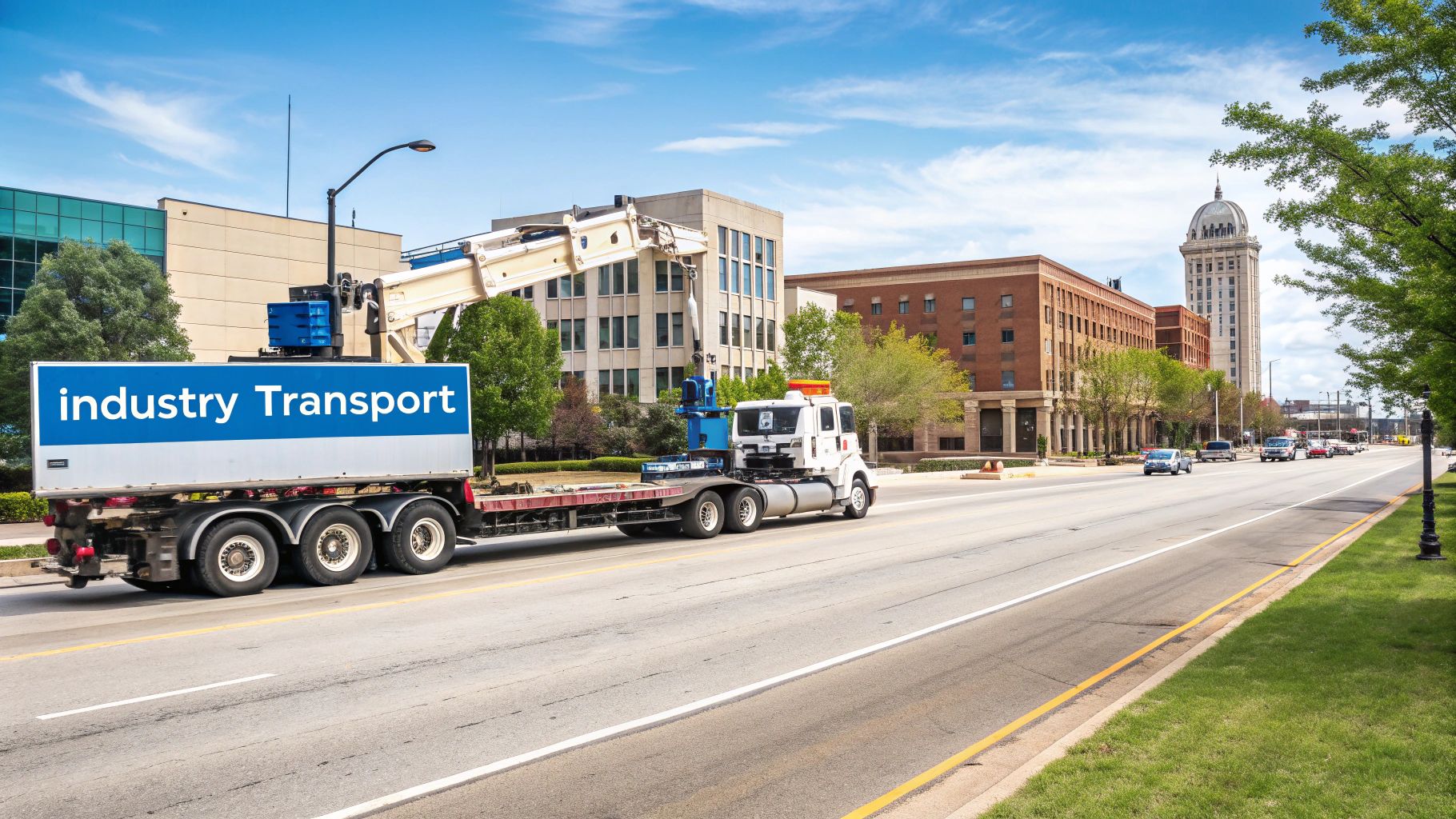
Understanding a lowboy trailer's design is one thing; seeing it solve a real-world transport challenge is another. These trailers are the unsung workhorses behind our largest industries, making monumental tasks feasible every day.
From building skyscrapers to powering cities, the lowboy is often the critical link in the logistical chain. Each of these industries presents unique challenges—from immense weight and awkward dimensions to fragile, high-value components. For these jobs, a standard trailer is simply not an option.
Construction: Navigating the Urban Maze
Consider the challenge: a massive crane must be delivered to a high-rise construction site in a dense urban center. The route is a gauntlet of low bridges, sharp turns, and overhead power lines. A standard flatbed is a non-starter; the load would be too high, creating an immediate and dangerous hazard.
This is a classic job for a lowboy trailer, specifically a multi-axle Removable Gooseneck (RGN).
- Solving the Height Problem: The signature low deck provides the extra inches of clearance needed to slip under overpasses, which can be as low as 14 feet in older urban areas.
- Making Loading Easy: The RGN's detachable neck is a game-changer. The crane operator can simply drive the machine’s base directly onto the deck, avoiding hours of risky and complex lifting operations.
- Handling the Weight: The numerous axles distribute the crane's immense weight across the pavement, ensuring compliance with strict city and bridge weight limits and preventing costly damage to public infrastructure.
Without the right lowboy, a project like this would be mired in delays and logistical nightmares, fundamentally changing how we build our cities.
Agriculture: Keeping Up with the Harvest
In farming, timing is everything. During the harvest window, farmers must move combines and tractors between fields that can be miles apart, and they must do it quickly. This equipment is not only heavy but also extremely wide, easily exceeding standard road limits.
A lowboy makes this rapid deployment possible. An operator can drive a $500,000 combine onto an RGN, secure it, and transport it to a new field in a fraction of the time it would take to drive it on public roads. That efficiency can be the difference between a successful harvest and a loss.
Actionable Insight: The ability to quickly move heavy equipment allows farmers to work more land with fewer machines. A single lowboy can service an entire fleet, keeping that expensive equipment in the field and productive, which is absolutely key to the economics of modern agriculture.
Energy: Powering the Nation
The energy sector transports some of the most challenging cargo imaginable. Consider hauling a 150-foot-long wind turbine blade to a remote mountain ridge or moving a multi-ton transformer to a substation. This is where specialized "stretch" lowboy trailers prove their worth.
These trailers feature an extendable deck to accommodate the extreme length of a turbine blade while keeping the load low and stable. For a transformer, a multi-axle lowboy with a deep "well" is used to lower its center of gravity and clear overhead lines. These are not simple hauls; they require meticulous route planning, pilot cars, and extensive permits. At the heart of it all is the lowboy trailer, the tool that makes it all possible.
This constant demand is why the global lowboy semi-trailer market is growing so steadily. As long as we're building and maintaining infrastructure, the need for reliable heavy-haul solutions in construction, energy, and defense will continue to drive the market. To get a better sense of the numbers, you can dig into the latest lowboy market analysis. Each of these examples tells the same story: the smart engineering behind the lowboy trailer is the answer to some of transportation's toughest questions.
Navigating the Complex Rules of Heavy Haul Transport
https://www.youtube.com/embed/oQI9qiLLIwA
Moving a massive piece of equipment on a lowboy trailer is a logistical puzzle governed by a web of federal, state, and local regulations. These rules exist to protect our infrastructure and ensure public safety. Ignoring them can lead to crippling fines, project delays, and dangerous accidents.
Every state has its own rulebook for heavy hauling. To get from point A to point B, you must comply with the regulations of every single state you pass through.
Understanding the Key Regulations
The most fundamental rule is the Federal Bridge Gross Weight Formula. This is not a simple weight limit; it's a complex formula that considers axle spacing and total weight to prevent concentrating too much stress on bridges. Multi-axle lowboys are designed specifically to distribute weight and comply with this law.
State-specific rules, like Frost Laws, add another layer of complexity. In colder climates, roads become vulnerable during the spring thaw. States enforce temporary weight restrictions, meaning a load that is legal in the summer might be illegal in the spring.
Critical Insight: The number of axles on your lowboy trailer is your key to complying with bridge laws. The more axles you have, the more you spread out the load's weight. This reduces the pressure on the road surface and makes it possible to legally transport heavier equipment.
Permits and Safety Gear Are Not Optional
Virtually any haul requiring a lowboy trailer will need special permits. If your load is wider than 8.5 feet, taller than 13.5 feet, or exceeds standard length and weight limits, it is classified as an "oversize load." You must obtain the correct permits from every state on your route before transport begins. This process can be time-consuming, as each state has its own system and fees.
In addition to permits, specific safety equipment is mandatory to warn other motorists.
- Banners and Flags: Bright red flags and prominent yellow "Oversize Load" banners are required on both the front of the truck and the rear of the trailer.
- Warning Lights: Flashing or rotating amber lights are typically required on the truck and sometimes on escort vehicles to maximize visibility.
- Pilot or Escort Vehicles: For particularly large loads, one or more pilot cars are required to travel ahead of and behind the truck. They manage traffic, provide warnings of upcoming hazards, and ensure a clear path.
Managing these details can be overwhelming. This is why partnering with an experienced heavy hauler is often the most practical choice. For a detailed breakdown of the process, this guide on hauling oversize loads offers valuable insights. Meticulous planning is what separates a smooth transport from a logistical disaster.
How to Select the Right Lowboy for Your Cargo
Choosing the wrong lowboy trailer is a costly mistake. It can lead to delays, fines, and unsafe transport conditions. To select the right trailer, you must answer four critical questions about your cargo and route before the transport is booked.
Think of these four points as the foundation of a successful heavy haul. Getting them right ensures you match the perfect trailer to your job, guaranteeing a safe, efficient, and legal move.
1. What's the Exact Weight of the Load?
First and foremost: weight. You need the precise operating weight of your equipment. This single number determines the axle configuration required for the lowboy trailer. Underestimating the weight risks a serious violation of federal bridge laws and could result in being shut down mid-route.
A standard two-axle lowboy can typically handle up to 40,000 pounds. For heavier equipment like large excavators, cranes, or dozers, you will need a three-axle (tridem) or even a more complex multi-axle setup. Adding axles is the method for legally distributing the load's weight to protect roads and bridges.
2. What Are Its Dimensions?
Next, you need exact measurements: height, width, and length. The total loaded height—the height of your machine plus the trailer's deck height—is critical. This determines whether you will clear every overpass and power line. A lowboy’s deck, sitting at just 18 to 24 inches, provides that crucial extra clearance.
You must also confirm if your cargo fits within the trailer's "well," the usable deck space which is generally 24 to 29 feet long. If your machine is longer, a specialized stretch trailer will be necessary.
3. How Is the Equipment Loaded?
This question helps determine if you need a Removable Gooseneck (RGN) trailer. If your equipment can be driven onto the trailer under its own power—such as a paver, dozer, or agricultural tractor—an RGN is almost always the best option.
An RGN’s front-detaching gooseneck creates a full-width, ground-level ramp. This is a complete game-changer for both safety and efficiency, as it means no more sketchy ramp setups or waiting on a crane. It saves a ton of time and labor on the job site.
Conversely, if you are moving static cargo, like an industrial tank or a factory component, a simpler fixed-neck lowboy is a cost-effective solution, provided that cranes are available at both pickup and delivery locations.
4. What Is the Route Like?
Finally, the entire route must be evaluated. This goes beyond checking for low bridges. You need to consider the real-world driving conditions.
- Road Conditions: Will the route be on smooth highways, or will it involve rough, unpaved roads that require a more robust suspension?
- Turns and Maneuverability: Will the transport navigate tight urban streets or winding rural roads? Some routes are impassable for a long, rigid trailer.
- State Regulations: Every state line crossed can mean a new set of rules. You must be aware of different weight limits, height restrictions, and permit requirements for each leg of the journey.
By systematically addressing these four questions, you create a blueprint for your haul. This methodical approach removes the guesswork from a complex logistical challenge and ensures you select the perfect lowboy for the job, every time.
Common Questions About Lowboy Trailers
When planning a heavy haul, numerous questions arise. Getting the details right is not just about logistics; it’s about ensuring your high-value equipment arrives safely and legally. Here are answers to some of the most common questions from shippers.
This is your quick-start guide to understanding the key practicalities of lowboy transport.
What Is the Maximum Weight a Lowboy Can Carry?
There is no single answer, as a lowboy's capacity depends entirely on its axle configuration. A basic 2-axle lowboy typically handles around 40,000 pounds. However, specialized multi-axle configurations can transport permitted loads well over 100,000 pounds.
The true limit is determined by federal and state bridge law formulas, which are designed to distribute weight to protect infrastructure. The more axles a trailer has, the more effectively the weight is distributed, and the heavier the legal payload can be.
When Do I Need a Removable Gooseneck (RGN) Trailer?
The simple rule is: if your equipment is self-propelled, you should use an RGN. This applies to any drivable machinery, including excavators, bulldozers, agricultural tractors, and pavers.
The key feature of the Removable Gooseneck is that the front of the trailer detaches and lowers to the ground, creating a full-width ramp. This allows operators to simply drive the machine on and off. It eliminates the need for coordinating cranes or using cumbersome external ramps, making the entire process faster, safer, and more efficient.
Actionable Tip: For any drivable machinery, an RGN is your best bet. It simplifies the job by cutting out the need for extra lifting equipment at your pickup and drop-off sites, which can be a huge time and cost saver.
Are Special Permits Always Required for Lowboy Transport?
While not required for every haul, they are necessary for most. The moment your load exceeds the standard legal limits for weight, width (typically 8.5 feet), or height (usually 13.5 feet), you are in permit territory.
Since lowboy trailers are specifically designed to transport oversized and overweight freight, it is wise to assume that a permit will be required. Factoring the time and cost for permitting into your plan from the outset is standard practice in the heavy haul industry.
Navigating the complexities of heavy haulage requires expertise. At We Will Transport It, our logistics specialists manage these details daily. We handle everything from selecting the right trailer to ensuring all necessary permits are secured for a seamless delivery. Learn more about our transport services and get a free quote today!


